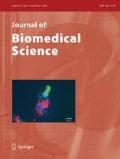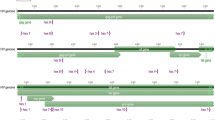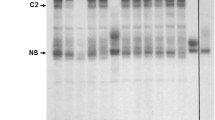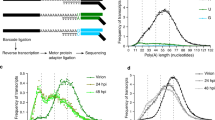Abstract
A ‘G-less’ cassette was cloned downstream of the human immunodeficiency virus type 1 (HIV-1) long terminal repeat (LTR) to facilitate rapid identification of authentic LTR-directed transcription in T cell nuclear extracts. Despite a high constitutive level of transcription, addition of chemically synthesized full-length HIV-1bru tat (amino acids 1–86) stimulated transcription 3-fold but only if the template included the TAR region of the LTR. Suppression of basal transcription in T cell nuclear extracts by sodium citrate increased the relative level oftat stimulation, but neither potassium chloride nor histone H1 had an effect. A mutant synthetictat polypeptide, lacking residues 22–32 in the cysteine-rich domain, was inactive in uptake assays and failed to stimulate transcription. Short basic peptides that competed full-lengthtat from complexes with TAR RNA also inhibitedtat stimulation of transcription, whereas short basic peptide unable to bind TAR or competetat from complexes were also unable to inhibittat stimulation of transcription. These data confirm that active HIV-1tat must first interact with TAR RNA via basic amino acid residues in order to stimulate transcription of downstream sequences.
Similar content being viewed by others
References
Bengal E, Aloni Y. Transcriptional elongation by purified RNA polymerase II is blocked at the transactivation response region of human immunodeficiency virus in vitro. J Virol 65:4910–4918;1991.
Berkhout B, Jeang KT. Transactivation of human immunodeficiency virus type 1 is sequence specific for both the single-stranded bulge and loop of the trans-acting-responsive hairpin: A quantitative analysis. J Virol 63:5501–5504;1989.
Berkhout B, Gatignol A, Rabson AB, Jeang KT. TAR-independent activation of the HIV-1 LTR: Evidence thattat requires specific regions of the promoter. Cell 62:757–767;1990.
Berkhout B, Silverman RH, Jeang KT. Tat transactivates the human immunodeficiency virus through a nascent RNA target. Cell 59:273–282;1989.
Bohan CA, Kashanchi F, Ensoli B, Buonaguro L, Boris-Lawrie KA, Brady JN. Analysis oftat transactivation of human immunodeficiency virus transcription in vitro. Gene Expr 2:391–407;1992.
Brake DA, Debouck C, Biesecker G. Identification of an Arg-Gly-Asp (RGD) cell adhesion site in human immunodeficiency virus type 1 transactivation protein,tat. J Cell Biol 111:1275–1281;1990.
Calnan BJ, Biancalana S, Hudson D, Frankel A. Analysis of arginine rich peptides from the HIVtat protein reveals unusual features of RNA-protein recognition. Genes Dev 5:201–210;1991.
Calnan BJ, Tidor B, Biancalana S, Hudson D, Frankel A. Arginine mediated RNA recognition: The arginine fork. Science 252:1167–1171;1991.
Carroll R, Martarano L, Derse D. Identification of lentivirustat functional domains through generation of equine infectious anemia virus/human immunodeficiency virus type 1tat gene chimeras. J Virol 65:3460–3467;1991.
Clark-Lewis I, Moser B, Walz A, Baggiolini M, Scott GJ, Aebersold R. Chemical synthesis, purification, and characterization of two inflammatory proteins, neutrophil activating peptidel (interleukin-8). Biochemistry 30:3128–3135;1991.
Colvin RA, Garcia-Blanco MA. Unusual structure of the human immunodeficiency virus type 1 transactivation response element. J Virol 66:930–935;1992.
Cordingley MG, Lafemia RL, Callahan PL, Condra JH, Sardana VV, Graham DJ, Nguyen TM, Legrow K, Gotlib L, Schlabach AJ, Colonna RJ. Sequence specific interaction oftat protein andtat peptides with the transactivation responsive sequence element of human immunodeficiency virus type 1 in vitro. Proc Natl Sci USA 87:8985–8989;1990.
Croston GE, Kerrigan LA, Lira LM, Marshak DR, Kadonaga JT. Sequence-specific antirepression of histone H1-mediated inhibition of basal RNA polymerase II transcription. Science 251:643–649;1991.
Cullen BR. Trans-activation of human immunodeficiency virus occurs via a bimodal mechanism. Cell 46:973–982;1986.
Delling U, Roy S, Sumner-Smith M, Barnett R, Reid L, Rosen CA, Sonenberg N. The number of positively charged amino acids in the basic domain oftat is critical for trans-activation and complex formation with TAR RNA. Proc Natl Acad Sci USA 88:6234–6238;1991.
Dignam JD, Lebovitz RM, Roeder RG. Accurate transcription initiation by RNA polymerase II in a soluble extract from isolated mammalian nuclei. Nucleic Acids Res 11:1475–1489;1983.
Dingwall C, Ernberg I, Gait MJ, Green SM, Heaphy S, Karn J, Lowe AD, Singh M, Skinner MA, Valerio R. Human immunodeficiency 1tat protein binds trans-activation-response region (TAR) RNA in vitro. Proc Natl Acad Sci USA 86:6925–6929;1989.
Dingwall C, Ernberg I, Gait MJ, Green SM, Heaphy S, Karn J, Lowe AD, Singh M, Skinner MA. HIV-1tat protein stimulates transcription by binding to a U-rich bulge in the stem of the TAR RNA structure. EMBO J 9:4145–4153;1990.
Feng S, Holland EC. HIV-1tat transactivation requires the loop sequence withintar. Nature 334:165–167;1988.
Flanagan WM, Crabtree GR. In vitro transcription faithfully reflecting T-cell activation requirements. J Biol Chem 256:1183–1192;1991.
Frankel AD, Bredt DS, Pabo CO. Tat protein from human immunodeficiency virus forms a metal linked dimer. Science 240:70–73;1988.
Frankel AD, Chen L, Cotter RJ, Pabo CO. Dimerization of thetat protein from human immunodeficiency virus: A cysteine rich peptide mimics the normal metal-linked dimer interface. Proc Natl Acad Sci USA 85:6297–6300;1988.
Graeble MA, Churcher MJ, Lowe AD, Gait MJ, Karn J. Human immunodeficiency virus type 1 transactivator protein,tat, stimulates transcriptional read-through of distal terminator sequences in vitro. Proc Natl Acad Sci USA 90:6184–6188;1993.
Harper JW, Logsdon NJ. Refolded HIV-1tat protein protects both bulge and loop nucleotides in TAR RNA from ribonucleolytic cleavage. Biochemistry 30:8060–8066;1991.
Harrich D, Garcia J, Mitsuyasu R, Gaynor R. TAR independent activation of the human immunodeficiency virus in phorbol ester stimulated T-lymphocytes. EMBO J 9:4417–4423;1990.
Haseltine WA. Regulation of HIV-1 replication bytat andrev. In: Haseltine WA, Wong-Staal F, eds. Genetic Structure and Regulation of HIV. New York, Raven, 1–42;1991.
Hauber J, Cullen BR. Mutational analysis of the trans-activation-response region of the human immunodeficiency virus type 1 long terminal repeat. J Virol 62:673–679;1988.
Huang RCC, Chow WY, Li C, Yao CW, Chen MC, Walls LC, Kung HJ. Regulation of HIV promoter activities in human embryonal carcinoma cells, NTERA-2. In: Papas TS, ed. Gene Regulation and AIDS. New York, Raven, 147–160;1990.
Jacobovits A, Smith DH, Jacobovits EB, Capon DJ. A discrete element 3′ of human immunodeficiency virus 1 (HIV-1) and HIV-2 mRNA initiation sites mediates transcriptional activation by an HIV-1 transactivator. Mol Cell Biol 8:2555–2561;1988.
Jeang KT, Chang YN, Berkhout B, Hammarskjold ML, Rekosh D. Regulation of HIV expression: Mechanism of action oftat andrev. AIDS 5(suppl 2):3–14;1991.
Jeyapaul J, Reddy MR, Khan SK. Activity of synthetictat peptides in human immunodeficiency virus type 1 long terminal repeat-promoted transcription in a cell-free system. Proc Natl Acad Sci USA 87:7030–7034;1990.
Kamine J, Loewenstein P, Green M. Mapping of HIV-1tat protein sequences required for binding to Tar RNA. Virology 182:570–577;1991.
Kao SY, Calman AF, Luciw PA, Peterlin BM. Anti-termination of transcription within the long terminal repeat of HIV-1 bytat gene product. Nature 330:489–493;1987.
Kato H, Sumimoto H, Pognonec P, Chen CW, Rosen CA, Roeder RG. HIV-1tat acts as a processivity factor in vitro in conjunction with cellular elongation factors. Genes Dev 6:655–666;1992.
Kornberg RD, Lorch Y. Irresistible force meets immovable object: Transcription and the nucleosome. Cell 67:833–836;1991.
Kuppuswamy M, Subramanian T, Srinivasan A, Chinnadurai G. Multiple functional domains of Tat, the transactivator of HIV-1, defined by mutational analysis. Nucleic Acid Res 17:3551–3556;1989.
Laspia MF, Rice AP, Mathews MB. HIV-1 Tat protein increases transcriptional initiation and stabilises elongation. Cell 59:283–292;1989.
Laspia MF, Rice AP, Mathews MB. Synergy between HIV-1tat and adenovirus E1A is due to stabilisation of transcriptional elongation. Genes Dev 4:2397–2408;1990.
Laspia MF, Wendel P, Mathews MB. HIV-1tat overcomes inefficient transcriptional elongation in vitro. J Mol Biol 232:732–746;1993.
Lee VHL, ed. Peptide and Protein Drug Delivery. New York, Marcel Dekker; 1991.
Lubon H, Ghazal P, Nelson JA, Henninghausen L. Cell-specific activity of the human immunodeficiency virus enhancer repeat in vitro. AIDS Res Hum Retroviruses 4:381–391;1988.
Maire P, Wuarin J, Schibler U. The role of cis-acting promoter elements in tissue-specific albumin gene expression. Science 244:343–346;1989.
Manley JL, Fire A, Samuels M, Sharp PA. In vitro transcription: Whole cell extracts. Methods Enzymol 101:368–382;1983.
Marciniak RA, Calnan BJ, Frankel AD, Sharp PA. HIV-1tat protein transactivates transcription in vitro. Cell 63:791–802;1990.
Marciniak RA, Garcia-Blanco MA, Sharp PA. Identification and characterization of a HeLa nuclear protein that specifically binds to the transactivation-response (TAR) element of human immunodeficiency virus. Proc Natl Acad Sci USA 87:3624–3628;1990.
Marciniak RA, Sharp PA. HIV-1tat protein promotes formation of more processive elongation complexes. EMBO J 10:4189–4196;1991.
Meusing MA, Smith DH, Capon DJ. Regulation of mRNA accumulation by a human immunodeficiency virus trans-activator protein. Cell 48:691–701;1987.
Okamoto T, Wong-Staal F. Demonstration of virus-specific transcriptional activator(s) in cells infected with HTLV-III by an in vitro cell-free system. Cell 47:29–35;1986.
Ptashne M, Gann AAF. Activators and targets. Nature 346:329–331;1990.
Puglisi JD, Tan R, Calnan BJ, Frankel AD, Williamson JR. Conformation of the TAR RNA-arginine complex by NMR spectroscopy. Science 257:76–80;1992.
Rappaport J, Lee SJ, Khalili K, Wong-Staal F. The acidic amino terminal region of the HIV-1tat protein constitutes an essential activating domain. New Biol 1:101–110;1989.
Rice AP, Mathews M. Transcriptional but not translational regulation of HIV-1 by thetat gene product. Nature 332:551–553;1988.
Roberts CM, Blair ED. Exploitation of a rapid and sensitive assay to characterise transactivation of the HIV-1 LTR. Antiviral Chem Chemother 1:139–148;1990.
Rosen CA, Sodroski JG, Haseltine WA. The location of cis-acting regulatory sequences in the human T-cell lymphotropic virus type III (HTLV-III/LAV) long terminal repeat. Cell 41:813–823;1985.
Roy S, Delling U, Chen CH, Rosen CA, Sonenberg N. A bulge structure in HIV-1 TAR RNA is required fortat binding andtat-mediated trans-activation. Genes Dev 4:1365–1373;1990.
Sawadogo M, Roeder RG. Factors involved in specific transcription by human RNA polymerase II: Analysis by a rapid and quantitative in vitro assay. Proc Natl Acad Sci USA 82:4394–4398;1985.
Selby MJ, Bain ES, Luciw PA, Peterlin BM. Structure, sequence and position of the stem loop intar determine transcriptional elongation bytat through the HIV-1 long terminal repeat. Genes Dev 3:547–558;1989.
Selby MJ, Peterlin BM. Transactivation by HIV-1 Tat via a heterologous RNA binding protein. Cell 62:769–776;1990.
Shapiro DJ, Sharp PA, Wahli W, Keller MJ. A high-efficiency HeLa cell nuclear transcription extract. DNA 7:47–55;1988.
Sharp PA. TFIIB or not TFIIB? Nature 351:16–18;1991.
Sharp PA, Marciniak RA. HIV TAR: An RNA enhancer? Cell 59:229–230;1989.
Sheline CT, Milocco LH, Jones KA. Two distinct nuclear transcription factors recognize loop and bulge residues of the HIV-1 TAR RNA hairpin. Genes Dev 5:2508–2520;1991.
Southgate C, Zapp ML, Green ML. Activation of HIV-1 transcription of HIV-1tat protein tethered to nascent RNA through another protein. Nature 345:640–642;1990.
Sumner-Smith M, Roy S, Barnett R, Reid LS, Kuperman R, Delling U, Sonenberg N. Critical chemical features in trans-acting responsive RNA are required for interaction with human immunodeficiency virus type 1tat protein. J Virol 65:5196–5202;1991.
Tiley L, Brown PH, Cullen BR. Does the human immunodeficiency virustat trans-activator contain a discrete activation domain? Virology 178:560–567;1990.
Weeks KM, Ampe C, Schulz SC, Steitz TA, Crothers DM. Fragments of HIV-1tat protein specifically bind TAR RNA. Science 249:1281–1285;1990.
Weeks KM, Crothers DM. RNA recognition bytat-derived peptides: Interactions in the major groove? Cell 66:577–588;1991.
Wright S. Regulation of eukaryotic gene expression by transcriptional attenuation. Mol Biol Cell 4:661–668;1993.
Wu F, Garcia J, Sigman D, Gaynor R. Tat regulates binding of human immunodeficiency virus transactivating region RNA loop-binding protein TRP-185. Genes Dev 5:2128–2140;1991.
Author information
Authors and Affiliations
Rights and permissions
About this article
Cite this article
Blair, E.D., Roberts, C.M. & Clark-Lewis, I. A simple and rapid TAR-dependent in vitro transcription assay using T cell nuclear extracts and synthetictat1-86 protein. J Biomed Sci 2, 136–145 (1995). https://doi.org/10.1007/BF02253064
Received:
Accepted:
Issue Date:
DOI: https://doi.org/10.1007/BF02253064




